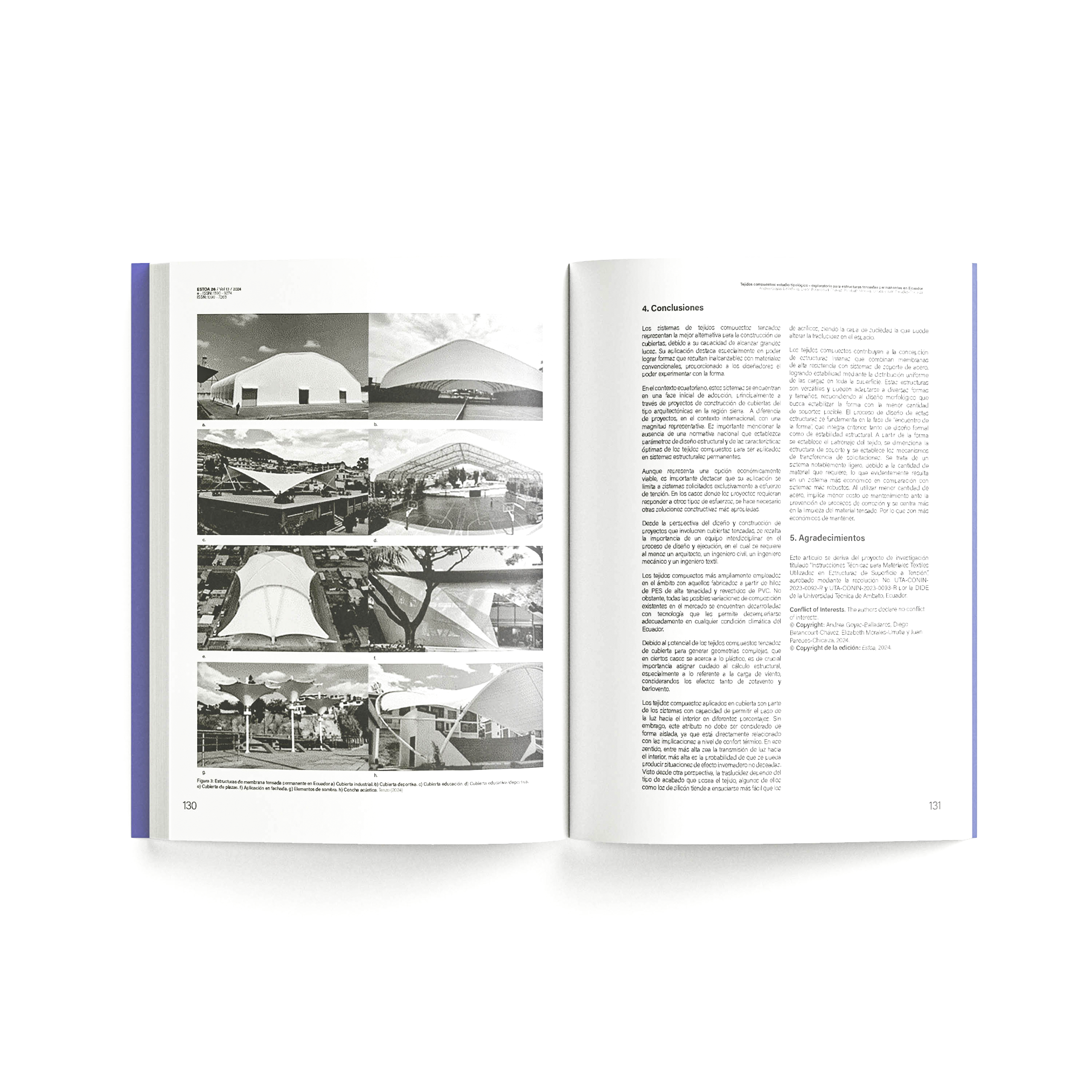Composite fabrics: Typological - exploratory study for permanent tensile structures in Ecuador
DOI:
https://doi.org/10.18537/est.v013.n026.a08Keywords:
tensile structures, composite fabrics, light weight structures, construction technologiesAbstract
Tensile structures represent a notable evolution of construction materials, from their incipient construction using fabrics made with natural fibers to fabrics developed with high-performance synthetic fibers, which show the transformation of engineering and the design of new materials. The purpose of this document is to explore the use of composite fabrics in permanent tensile structural systems in Ecuador. Exploratory descriptive research is carried out, which identifies the types of application through a systematic classification. The results obtained focus on the characteristics of the use of tensile structures, construction region and detail of the technical, mechanical and physical characteristics, from the structural element approach in tensioned systems.
Downloads
References
Aguirregabiria, B. L. (2019). Materiales 2: Arquitectura Textil. http://oa.upm.es/57155/
Ambroziak, A., y Kłosowski, P. (2017). Mechanical properties of Precontraint 1202 S2 based on uniaxial tensile and creep tests. Journal of Reinforced Plastics and Composites, 36(4), 254–270. https://doi.org/10.1177/0731684416682604
American Society of Civil Engineers. (2017). Tensile membrane structures. In Tensile Membrane Structures ASCE/SEI 55-16. American Society of Civil Engineers. https://doi.org/10.1061/9780784414378
Antona, C. (2015). Estudio sobre la arquitectura textil [Bachelor’s thesis, Universidad de Alicante]. https://rua.ua.es/dspace/handle/10045/49689
Beccarelli, P. (2015). The design, analysis and construction of tensile fabric structures. In Biaxial Testing for Fabrics and Foils (Vol. 20, pp. 9–33). PoliMI SpringerBriefs. https://doi.org/10.1007/978-3-319-02228-4_2
Bedon, C. (2016). Review on the use of FRP composites for façades and building skins. American Journal of Engineering and Applied Sciences, 9(3), 713–723. https://doi.org/10.3844/ajeassp.2016.713.723
Berger, H. (1999). Form and function of tensile structures for permanent buildings. Engineering Structures, 21(8), 669–679. https://doi.org/https://doi.org/10.1016/S0141-0296(98)00022-4
Blonder, A., Latteur, P., y Grobman, Y. J. (2019). Introducing Fabric Materiality in architectural fibre composites. Textile Intersections, September, 0–10.
Bridgens, B. N., Gosling, P. D., y Birchall, M. J. S. (2004). Tensile fabric structures: Concepts, practice y developments. Structural Engineer, 82(14), 21–27.
British Standards Institution. (2023). Design of tensioned membrane structures. PD CEN/TS 19102:2023.
Carranza, F., y Taco, J. (2011). Cálculo y diseño estructural para la cubierta del Mercado Central de la parroquia de Píntag en base a tenso-estructura con el uso de Bambú Gigante (Dendrocálamus Asper) [Bachelor’s thesis, Escuela Politécnica del Ejército]. http://repositorio.espe.edu.ec/jspui/bitstream/21000/3175/1/T-ESPE-031072.pdf
Cerdá, M. (2019). Membranas Para Estructuras Superficiales Tensadas (Trabajo final de grado. Universidad Politécnica de Valencia). https://riunet.upv.es/bitstream/handle/10251/115286/memoria_20451381.pdf?sequence=1yisAllowed=y
Corazza, C. (2006). Mechanical characterization of technical textiles for the screen-printing: experimental tests and numerical analysis (Tesis doctoral, Politecnico di Milano).
Estructuras Tensadas. (2024). Technical specifications. Architectural Membranes. https://estructurastensadas.com/
Forster, B., y Mollaert, M. (2004). European design guide for tensile surface structures (TensiNet (ed.)).
Gosling, P. D., Bridgens, B. N., Albrecht, A., Alpermann, H., Angeleri, A., Barnes, M., Bartle, N., Canobbio, R., Dieringer, F., Gellin, S., Lewis, W. J., Mageau, N., Mahadevan, R., Marion, J.-M., Marsden, P., Milligan, E., Phang, Y. P., Sahlin, K., Stimpfle, B., … Uhlemann, J. (2013). Analysis and design of membrane structures: Results of a round robin exercise. Engineering Structures, 48, 313–328. https://doi.org/https://doi.org/10.1016/j.engstruct.2012.10.008
Hadvani, D., y Patel, V. R. (2022a). Comparisons of Tensile Structure with Conventional Steel Structure. International Journal of Advanced Research in Science, Communication and Technology, 2(9), 109–115. https://doi.org/10.48175/ijarsct-5307
Hadvani, D., y Patel, V. R. (2022b). Tensile Roof Structure. International Journal of Advanced Research in Science, Communication and Technology, 630–635. https://doi.org/10.48175/ijarsct-5084
Ivanova, L. (2022). Tensile fabric structures. world construction experience and prospects. Прикладная Геометрия и Инженерная Графика, 101, 96–107. https://doi.org/10.32347/0131-579x.2021.101.96-107
Kamal, M. A. (2020). An investigation into tensile structure system: construction morphology and architectural interventions. Journal of Building Materials and Structures, 7(2), 236–254. https://doi.org/10.34118/jbms.v7i2.776
Knippers, J., Cremers, J., Gabler, M., y Lienhard, J. (2011). Construction Manual for Polymers + Membranes: Materials/Semi-finished Products/Form Finding/Design (Birkhauser Verlag AG (ed.)).
Lin, E. S., y Roithmayr, R. (2015). Building Information Modeling: Next steps for tensile membrane architecture. VII International Conference on Textile Composites and Inflatable Structures, 93–104. http://www.tensileevolution.com/†http://www.tensileevolution.com/
Milosevic, V., Igic, T., y Kostic, D. (2013). Tensile structures as the most advanced lightweight structures. Facta Universitatis - Series: Architecture and Civil Engineering, 11(3), 269–284. https://doi.org/10.2298/fuace1303269m
Monjo-Carrió, J., y Tejera, J. (2011). The use of textile materials for architectural membranes. In Fibrous and Composite Materials for Civil Engineering Applications (Vol. 1). Woodhead Publishing Limited. https://doi.org/10.1533/9780857095583.3.325
Mubashra, A., Qamber, S. A., y Madaan, N. (2021). Architextiles : Design Multifunctional State. International Journal of Innovation, Creativity and Change, 15(8), 26–40. https://www.ijicc.net/images/Vol_15/Iss_8/15767_Mubashra_2021_E1_R.pdf
Rivas, C. (2018). Matices tensados, evolucion y nuevas aplicaciones de las estructuras tensadas [Bachelor’s thesis, Universidad Politécnica de Madrid]. [Universidad Politécnica de Madrid]. https://oa.upm.es/51881/
Santomauro, R. (2008). tensoestructuras-uruguay.pdf (Mastergraf (ed.)). https://laotracatedra.files.wordpress.com/2016/06/tensoestructuras-uruguay.pdf
São João, L., Carvalho, R., y Fangueiro, R. (2016). A Study on the Durability Properties of Textile Membranes for Architectural Purposes. Procedia Engineering, 155, 230–237. https://doi.org/doi.org/10.1016/j.proeng.2016.08.024
Schlaich, J., Bergermann, R., y Sobek, W. (1990). Membranas. Revista Digital Del Cedex, 75(33). http://tiposde.org/blog/informatica/33-tipos-de-antivirus/
Tenzo. (2024). Cubiertas sin límites. Proyectos Realizados. https://www.tenzo.ec/
Textile Institute. (2015). Fabric Structures in Architecture (J. I. de Llorens (ed.)). Woodhead Publishing Limited.
Tolani, A., Patil, G., Patil, A., Vadalkar, V., y Barbude, P. (2016). Advantages of Tensile Structures Over Other Space Frame Structures. International Journal of Research in Engineering and Technology, 05(05), 568–575. https://doi.org/10.15623/ijret.2016.0505106
Valdés, J. G., Miquel, J., y Oñate, E. (2009). Nonlinear finite element analysis of orthotropic and prestressed membrane structures. Finite Elements in Analysis and Design, 45(6–7), 395–405. https://doi.org/10.1016/j.finel.2008.11.008
Zhang, Y., Zhang, Q., y Lv, H. (2012). Mechanical properties of polyvinylchloride-coated fabrics processed with Precontraint® technology. Journal of Reinforced Plastics and Composites, 31(23), 1670–1684. https://doi.org/10.1177/0731684412459898

Downloads
Published
How to Cite
Issue
Section
License
Copyright (c) 2024 Estoa. Journal of the Faculty of Architecture and Urbanism

This work is licensed under a Creative Commons Attribution-NonCommercial-ShareAlike 4.0 International License.
The Journal declines any responsibility for possible conflicts derived from the authorship of the works that are published in it.
The University of Cuenca in Ecuador conserves the patrimonial rights (copyright) of the published works and will favor the reuse of the same ones, these can be: copy, use, diffuse, transmit and expose publicly.
Unless otherwise indicated, all contents of the electronic edition are distributed under a Creative Commons Attribution-NonCommercial-ShareAlike 4.0 International License.



